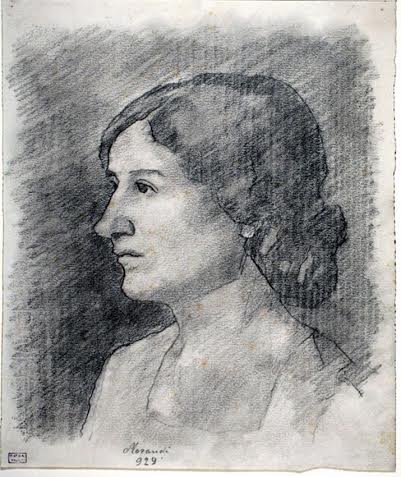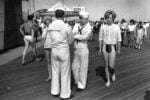Da Michelangelo alla contemporaneità

Un’esposizione che ripercorrerà i 450 anni attraverso i principali documenti degli Accademici, tra cui spiccano alcuni autografi galileiani e i primi statuti della Compagnia di San Luca.
Comunicato stampa
Firenze, 20 marzo 2014. Aprirà i battenti venerdì 21 marzo, nella prestigiosa sede dell’Archivio di
Stato di Firenze, la mostra “Da Michelangelo alla contemporaneità. Storia di un primato
mondiale. 450 anni dell'Accademia delle Arti del Disegno”, ideata dall'Accademia delle Arti
del Disegno in coproduzione con Archivio di Stato e Accademia di Belle Arti di Firenze, con il
supporto della Regione Toscana ed il contributo dell’Ente Cassa di Risparmio di Firenze.
La mostra, presentata oggi (giovedì 20 marzo ndr) alla stampa con una conferenza e una visita
esclusiva, è ospitata nei locali dell'Archivio di Stato e curata da Luigi Zangheri e Bert W.
Meijer, e ripercorre i 450 anni di storia dell'Accademia delle Arti del Disegno: oltre 150 le opere in
mostra, attraverso cui i visitatori possono ammirare l'evoluzione artistica dell'idea stessa di
disegno, da Michelangelo Buonarroti ai contemporanei.
Il riferimento a Michelangelo nasce spontaneo, e non solo perché fu uno dei due primi accademici
dell’Istituzione, insieme a Cosimo I de’Medici, insignito del titolo di "padre delle arti". Ma
quest’anno è anche il quattrocentocinquantesimo anniversario, oltre che della fondazione
dell’Accademia, proprio della morte del Buonarroti, tanto che nei prossimi mesi Firenze sarà
teatro di diversi eventi e iniziative culturali dedicati al suo genio e al suo talento creativo.
La volontà principale della mostra è, infatti, proprio quella di approfittare di questo doppio
anniversario per raccontare e testimoniare ai cittadini, attraverso la storia dell’Accademia “le
tappe di una costante attività artistica e culturale che, nel 1563, ha avuto origine a Firenze” ha
spiegato Luigi Zangheri, presidente dell’Accademia delle Arti del Disegno. “Troppo spesso,
infatti – ha proseguito – gli stessi fiorentini sono purtroppo i primi a dare per scontato l’enorme
patrimonio della cultura materiale e immateriale della loro città, senza più riconoscerne i segni
testimoni di un primato civile difficilmente uguagliabile, la cui valorizzazione rappresenta invece
un investimento non solo per il presente ma soprattutto per il futuro”.
E sul valore, per la città di Firenze, della secolare storia dell’Accademia ha insistito anche Carla
Zarrilli, direttrice dell’Archivio di Stato di Firenze, che ha ricordato la volontà, con questa
esposizione, di ripercorrere “la plurisecolare e gloriosa storia dell’Accademia, che va dal primo
accademico Michelangelo ai grandi artisti contemporanei che ne hanno fatto parte”.
Una storia straordinaria, raccontata in modo diacronico, con una raccolta di veri e propri tesori:
documenti provenienti dall’Archivio dell’Accademia delle Arti del Disegno, quello dell’Accademia
di Belle Arti di Firenze e l’Archivio di Stato, insieme alle unità bibliografiche provenienti dalla
Biblioteca Nazionale Centrale di Firenze.
Non mancano preziosi manoscritti e antichi volumi provenienti da diverse biblioteche fiorentine, e
ancora quadri che ritraggono gli accademici, disegni, incisioni, sculture in marmo, bronzo, gesso.
“Una mostra varia e complessa – ha concluso la direttrice dell’Archivio di Stato – in cui le varie tipologie di oggetti esposti ben si fondono a formare un quadro complessivo di grande ricchezza e
bellezza”.
Uno dei punti di maggiore interesse della mostra è dunque quello di essere la prima a raccogliere
insieme materiali delle due Accademie fiorentine, la cui storia è strettamente legata: l'Accademia
delle Arti del Disegno è, infatti, la più antica Accademia d'Arte dell'occidente, fondata nel 1563 da
Cosimo I e Giorgio Vasari, e proprio da una sua costola, con la riforma leopoldina del 1784,
nacque l'Accademia di Belle Arti.
Proprio sul legame tra le due Istituzioni culturali che nei secoli hanno fatto la storia dell’arte di
Firenze e del mondo si è concentrato, nel suo intervento, Luciano Modica, presidente
dell’Accademia di Belle Arti di Firenze: “È da auspicare che in un immediato futuro possano
esserci altre iniziative comuni – ha affermato – tra cui la ricerca di spazi espositivi permanenti per
entrambe le raccolte artistiche, che consentano di riunificare almeno in parte queste due
Istituzioni, entrambe di enorme importanza per la nostra città”.
E sull’importanza della mostra per Firenze, e sulla necessità di valorizzare un’Istituzione come
l’Accademia nel panorama culturale cittadino e non solo, ha insistito anche il Vice Presidente di
Ente Cassa di Risparmio di Firenze, Pierluigi Rossi Ferrini: “È significativo che una istituzione
come la nostra – ha dichiarato – sostenga da anni una Accademia così prestigiosa che
costituisce una delle pietre miliari della millenaria storia fiorentina. Non è solo un doveroso
omaggio per un passato illustre, ma è un segno di vicinanza e di attenzione per accompagnarla
nel proseguimento di una attività che ci auguriamo sia sempre luminosa e di altissimo livello’’.
Le oltre 150 opere in mostra si susseguono, secondo una suddivisione omogenea, nelle seguenti
sezioni:
• I luogotenenti
• I professori
• I premi
• La Wunderkammer
• I gessi
• Le incisioni
• I disegni
• La contemporaneità
“From Michelangelo to the Contemporary. History of a world leader. 450 years of the Accademia delle Arti del Disegno”
Presented to the press the exhibition to celebrate the 450 year history of the Accademia delle Arti del Disegno, which opens Friday, March 21 at the Archivio di Stato di Firenze
Florence, March 20, 2014. Opening on Friday, March 21, at the prestigious seat of the Archivio di Stato di Firenze, the exhibition "From Michelangelo to the Contemporary. The history of a world leader. 450 years of the Accademia delle Arti del Disegno", was conceived by the Accademia delle Arti del Disegno in co-production with the Archivio di Stato di Firenze and the Accademia di Belle Arti di Firenze, with the support of the Regione Toscana and the contribution of the Ente Cassa di Risparmio di Firenze.
The exhibition, housed in the Archivio di Stato and curated by Luigi Zangheri and Bert W. Meijer, was presented today to the press with a conference in which Eugenio Giani, President of the Consiglio Comunale di Firenze; Pierluigi Rossi Ferrini, Vice President of Ente Cassa di Risparmio di Firenze; Carla Zarrilli, Director of the Archivio di Stato di Firenze, Luigi Zangheri, President of the Accademia delle Arti del Disegno; and Cristina Frulli of the Accademia di Belle Arti di Firenze.
The exhibition traces the 450 year history of the Accademia delle Arti del Disegno with more than 150 works through which visitors can admire the artistic evolution of the idea of drawing from Michelangelo Buonarroti to the contemporaries.The reference to Michelangelo is spontaneous, and not just because he was one of the first two academics of the institution, together with Cosimo I de 'Medici, but because he was awarded the title of "father of the Arts". This year marks the 450th anniversary, as well as the founding of the Accademia, of the death of Michelangelo, so that in the coming months Florence will host various events and cultural initiatives dedicated to his genius and his creative talent.
The intention of the exhibition is, in fact, to take advantage of this double anniversary to tell and show to the people, through the history of the Accademia “the stages of a constant artistic and cultural activity that, in 1563, had its origins in Florence", explained Luigi Zangheri. "Too often, in fact - he continued - the Florentines themselves are, unfortunately, the first to take for granted the enormous wealth of material and immaterial culture of their city, no longer discern the signs of a primacy of civilian witnesses hardly uguagliabile, whose value is instead an investment not only for the present but also for the future".
Carla Zarrilli, Director of the Archivio di Stato, insists that this exhibition, retracing “the centuries long and glorious history of the Accademia, the first academy of Michelangelo, and the great contemporary artists who have been involved”, but also, as part of the Archivio di Stato, “the willingness to be open to modernity, to be more and more a center of attraction for the cultural life of Florence and the nation”. The President of the Consiglio di Firenze also anticipted the centrality of the Archivio di Stato for future celebrations for the 150th anniversary of “Firenze Capitale” that will begin February 3, 2015. The Archivio di Stato, anticipated by Eugenio Giani, “will host, on this occasion, an exhibition on the figure of Giuseppe Poggi, the figure of fundamental importance for the history of Florence, as well as for the Archivio di Stato, on the avenues that he designs it.” Giani then focused on the need to make known to the public the history of the two Florentine art accademies that “for 500 years, together with the Accademia del Cimento, have been the crucible of heritage education in the arts and sciences, in a city like Florence, not within the University”.
An extraordinary story, that of the two academias, told in a diachronic, with a collection of treasures among which are works by Canova, Morandi, Factors, De Chirico, and documents such as the status of the Accademia in 1563, the defense of Galileo Galilei, a letter from Vasari to Cosimo I, and a project by architect Renzo Piano, to which are added other documents recovered from the Archives and libraries of the city: manuscripts, ancient books and paintings depicting still academics, drawings, engravings, and sculptures in marble, bronze and plaster.
One of the most interesting points of the exhibition is, therefore, that it is the first to gather together the materials of the two Academies of Florence, whose history is closely linked: in fact the Accademia delle Arti del Disegno is the oldest art academy of the West, founded in 1563 by Giorgio Vasari and Cosimo I, and as if from one of its ribs, with the Riforma Leopoldina of 1784, the Accademia di Belle Arti was born.
Speaking to the link between these two cultural Institutions – that for centuries have shaped the history of the art of Florence and of the world, in his speech, Professor Cristina Frulli, according to which joint initiatives have the great advantage, as well as to “bear witness to the close ties between the two academies,” also “raise awarness, especially among the young, of the city’s past, as always, in its history, the mother of ideas throughout Europe.”
The exhibition also highlights the importance of Florence, and the need to enhance the Accademia as an institution in the cultural landscape of the city and not only that, Pierluigi Rossi Ferrini insisted "It is significant that an institution like ours supports such a prestigious Accademia, which is one of the cornerstones of the millennial history of Florence . It is not only a fitting tribute to an illustrious past, but it is a sign of closeness and attention, to accompany the Accademia delle Arti del Disegno on the continuation of an activity that we hope will be always bright and very high level, but also a way to answer one of the purposed of the Ente Cassa di Risparmio, which is to presevere the cultural heritage, making them usable and promote knowledge because to under stand the present, and lay the foundations of the furutre, you need to be rooted in the past.”
The more than 150 works are on display one after another, according to a homogeneous distribution in the following sections:
Lieutenants
Professors
Awards
Wunderkammer
Chalkworks
Incisions
Drawings
Contemporary



